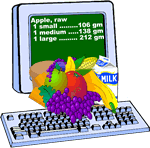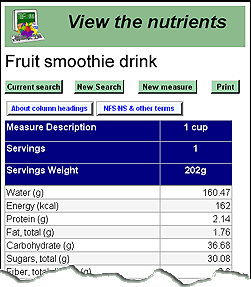This page has been archived and is being provided for reference purposes only. The page is no longer being updated, and therefore, links on the page may be invalid.
|
|
Free Searchable Database on Food Content
By Rosalie Marion Bliss
July 28, 2005
What nutrients were in the smoothie you just ate? Was it a two-cup serving made with fruit? Or was it a 20-fluid-ounce smoothie made with fruit and yogurt? The answers can be found on the Internet, where free access is now available to nutrient information on thousands of foods typically eaten in the United States.
Agricultural Research Service (ARS) scientists today launched a searchable database on the World Wide Web where users can view a 60-nutrient profile for each of more than 13,000 foods. The new resource is called "What's in the Foods You Eat—Search Tool."
|
|
By providing information on the nutrient values in typically consumed foods, the new online search tool will help consumers make informed decisions about food choices.
The tool was produced by nutritionists with the ARS Food Surveys Research Group, based at Beltsville, Md., and headed by supervisory nutritionist Alanna Moshfegh. ARS is the U.S. Department of Agriculture's chief scientific research agency.
The data are provided in commonly consumed portion sizes and weights, and easy-to-use help screens are readily available. To access the database on the World Wide Web, go to:
www.ars.usda.gov/foodsearch
A user starts by typing descriptive words into the online search box. After the user hits "Enter" or "Search," all food names containing the key words will be displayed. The user can then select one of the displayed food names and request information on up to three different portion amounts for it.
The computer search program generates a customized table showing 60 different nutrient values for each portion amount chosen. The search result can then be printed.
The versatile database expands the use of one of the laboratory's key research products, the USDA Food and Nutrient Database for Dietary Studies (FNDDS 1.0), which is a technical database for nutrition researchers.


